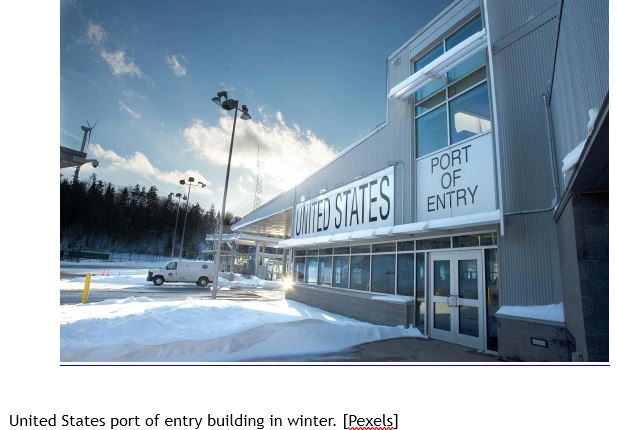CAA comment
This is an important article by Break the Needle and is particularly insightful in exposing our risk factors about illicit Drugs.
It highlights the folly of looking at risk factors on imports from other countries and how they may be used as a drug conduit.
Canada would be seen as a friendly neighbour to the US, which shares much in common with its northern neighbour. It is not unlike the relationship between New Zealand and Australia, so it is very possible that our border security takes less notice of imports from across the ditch than those from other Asian and friendly European countries.
Trump has cleverly used Tariffs as a weapon to have US neighbours take appropriate action against Drug and people smuggling operations.
We do not doubt that Trump would accept any adverse retaliatory action with his tariff strategy to prove that he is not bluffing.
Depending on how this strategy plays out, Australia could become the epicentre of drug use as criminal gangs unable to access or with reduced access to the US market, look further afield for a suitable market and, given the high retail price of drugs in Australia that will be where they first look.
We can only hope that our legislators are a wake-up and prepared for any onslaught because if the cat gets out of the bag, trying to rein in any influx will be extremely difficult, if not impossible.
Make our borders drug proof or we all suffer.

Trump’s tariff threat has ignited debate over Canada’s role in fentanyl trafficking. Sources say Canada is a key player.
On Wednesday, US President Donald Trump’s nominee for commerce secretary, Howard Lutnick, caused a stir when he said Canada and Mexico could avoid 25 per cent tariffs if they stop fentanyl and illegal migrants from coming into the US.
“As far as I know, they are acting swiftly, and if they execute it, there will be no tariff,” Lutnick said at a US Senate Commerce Committee hearing.
Ottawa and several provinces have launched border security initiatives to respond to the threat of tariffs. However, there is disagreement over whether fentanyl trafficking is a legitimate issue in Canada.
Data and sources paint a complex picture. While the volume of fentanyl seizures is low, some sources indicate Canada is a hub in the global fentanyl trade.
‘Massive’
In his comments about drug trafficking at the Canadian border, Trump has focused on fentanyl specifically.
“The fentanyl coming through Canada is massive,” Trump said at a Jan. 21 press conference, where he reiterated his threat to impose 25 per cent tariffs on Canadian goods.
Fentanyl claims tens of thousands of American lives each year.
In 2023, fentanyl and related drugs such as carfentanyl were responsible for an estimated 74,702 overdose deaths in the US, according to the Centers for Disease Control and Prevention.
Fentanyl is a synthetic opioid up to 50 times more potent than heroin and 100 times stronger than morphine, making even minor border seizures significant. A potentially lethal dose is just two milligrams — roughly the size of a few grains of salt.
The U.S. Border Patrol and the Office of Field Operations recorded the seizure of 19.5 kg of fentanyl along the entire US-Canada border in 2024. This is a tiny fraction of the nearly 10,000 kilograms of fentanyl seized across all US borders last year.
Of this haul, 9,600 kg was confiscated at the southern border with Mexico, where Mexican cartels are known for mass-producing the drug.
The Canada Border Services Agency seized just 4.9 kg of fentanyl between Jan. 1 and Oct. 31, 2024. Of this number, 4.1 kg was intercepted before it could be smuggled overseas, specifically toward the Netherlands, agency spokesperson Jacqueline Roby told Canadian Affairs in an emailed statement.
However, during this period, the agency seized about 21,500 kg of “other drugs, narcotics and precursor chemicals,” Roby said. Precursor chemicals refer to substances that are not explicitly identified as fentanyl but may include drugs and chemicals used in the production of fentanyl.
‘Limited to no evidence’
A spokesperson for the Ontario RCMP said Canada-produced fentanyl trafficking at the US-Canada border is not a significant issue.
“There is limited to no evidence or data from law enforcement agencies in the U.S. or Canada to support the claim that Canadian-produced fentanyl is an increasing threat to the U.S.,” the spokesperson said.
“Reports state fentanyl produced in Canada is being exported in micro shipments, most often through the mail. Micro traffickers are most often found on the dark web,” the spokesperson added.
David Asher, a former senior investigator with the US State Department, CIA and Drug Enforcement Administration’s Special Operations Division, shared a different perspective during an August 2024 interview with Canadian investigative journalist Sam Cooper.
Asher cited evidence suggesting fentanyl trafficking operations in Canada are highly organised.
“When we looked at the telephonic communications of Chinese organised criminals that DEA arrested in the US [for drug trafficking and money laundering] … there was an extraordinary amount of communication with Canada,” Asher said in the interview.
“It seemed like they were being controlled out of Canada, and I’m happy to say that on the record. We seized these people’s cell phones, ran them, and saw who they called in Canada.”
Asher also cited a lack of cooperation between Canadian authorities and US agencies in verifying the scale and operations of fentanyl trafficking networks.
“There’s very good reason to suspect that Canadian command and control continues, at least for money laundering and a fair extent of fentanyl precursor exports from Hong Kong and other parts of China,” he said.
“We’ve just not had adequate cooperation from the Canadian government.”
In 2022, the Criminal Intelligence Service Canada reported that organised crime groups had shifted from importing fentanyl-related products to sourcing chemical precursors from both international and domestic suppliers to manufacture the drug within Canada. The service is an inter-agency organisation that shares criminal intelligence between police forces in Canada.
In a 2024 report on organised crime in Canada, the intelligence service confirmed the extent of organised crime’s involvement in drug trafficking.
“Serious and organised crime remains a prominent threat to Canada’s security, contributing to thousands of deaths annually from overdoses due to illicit drugs, as well as firearms and gang violence,” the report said.
The intelligence service reported that international organised crime groups are leveraging Canada’s geographic location and borders to facilitate the illicit movement of goods — including drugs like fentanyl — between North America, Asia, Europe and Latin America.
The agency also reported an increase in dark web trafficking, which may explain the increased use of micro shipments and the role of online markets in the fentanyl trade.
Reports from the Canada Border Services Agency show a ninefold increase in fentanyl precursor chemical seizures in Canada between 2020 and 2021. In the first half of 2021 alone, the agency seized more than 5,000 kg of precursor chemicals used to produce fentanyl and other synthetic opioids, up from just 512 kg in 2020.
This transnational reach was further underscored in 2021 when Australian authorities intercepted their largest-ever illicit fentanyl shipment — more than 11 kg of fentanyl hidden in industrial equipment sent from Canada.
Nicholas Boyce, policy director at the Canadian Drug Policy Coalition, which advocates for drug policies focused on harm reduction and decriminalisation, is sceptical that border crackdowns will be effective in stopping the flow of illegal drugs and their precursors.
He pointed to the low inspection rate of sea containers at Canadian ports, often used to ship stolen cars.
A 2022 Canada Border Services Agency internal audit revealed that the agency’s target inspection rate is between just 1.5 per cent and 2 per cent. However, the agency has not met even this target in recent years. In 2021-22, the inspection rate was 1.1 per cent; in 2020-2021, it was 0.9 per cent.
“We cannot even stop stolen cars leaving the country — how can we expect to detect small packages of powders and chemicals?” Boyce said.
Editor’s note: This piece was updated to reference the 2022 report by the Criminal Intelligence Service Canada, the reports from the Canada Border Services Agency that show a ninefold increase in precursor chemical seizures, and the information about the Australian authorities’ fentanyl seizure in 2021.


With Australia’s growing passive and active ‘permission models’ parading as drug policy ensure more and more people perceive drug use as ‘normal’, the fentanyl traders will follow the cocaine peddlers to the ‘lucrative’ Aussies shores. https://www.abc.net.au/news/2023-05-22/cocaine-dealers-reveal-inner-workings-violent-drug-underworld/102331358
When illicit drug use is winked at, ignored or worse endorsed from upper echelon hedonists to the hapless self-medicating blue collar punter, then the ensuing dependency will all but ensure a fresh targeting of our already unravelling culture by the addiction for profit cartels.
This is not the manifestation off good societal governance and the gatekeepers of policy and community well-being must be held to a higher standard of care.